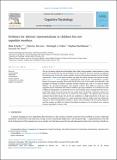Files in this item
Evidence for abstract representations in children but not capuchin monkeys
Item metadata
| dc.contributor.author | Felsche, Elisa | |
| dc.contributor.author | Stevens, Patience | |
| dc.contributor.author | Voelter, Christoph J. | |
| dc.contributor.author | Buchsbaum, Daphna | |
| dc.contributor.author | Seed, Amanda M. | |
| dc.date.accessioned | 2022-12-08T12:30:03Z | |
| dc.date.available | 2022-12-08T12:30:03Z | |
| dc.date.issued | 2023-02 | |
| dc.identifier | 282412492 | |
| dc.identifier | 7ac81c32-8198-4257-88bf-6324a497fe17 | |
| dc.identifier | 000905516400001 | |
| dc.identifier | 85145558956 | |
| dc.identifier | 000905516400001 | |
| dc.identifier.citation | Felsche , E , Stevens , P , Voelter , C J , Buchsbaum , D & Seed , A M 2023 , ' Evidence for abstract representations in children but not capuchin monkeys ' , Cognitive Psychology , vol. 140 , 101530 . https://doi.org/10.1016/j.cogpsych.2022.101530 | en |
| dc.identifier.issn | 0010-0285 | |
| dc.identifier.other | ORCID: /0000-0002-3867-3003/work/124490313 | |
| dc.identifier.uri | https://hdl.handle.net/10023/26559 | |
| dc.description | Funding: This project has received funding from the European Research Council (ERC) under the European Union’s Horizon 2020 research and innovation program (grant agreement No. [639072]). We acknowledge the support of the Natural Sciences and Engineering Research Council of Canada (NSERC), [funding reference number 2016-05552]. | en |
| dc.description.abstract | The use of abstract higher-level knowledge (also called overhypotheses) allows humans to learn quickly from sparse data and make predictions in new situations. Previous research has suggested that humans may be the only species capable of abstract knowledge formation, but this remains controversial. There is also mixed evidence for when this ability emerges over human development. Kemp et al. (2007) proposed a computational model of how overhypotheses could be learned from sparse examples. We provide the first direct test of this model: an ecologically valid paradigm for testing two species, capuchin monkeys (Sapajus spp.) and 4- to 5-year-old human children. We presented participants with sampled evidence from different containers which suggested that all containers held items of uniform type (type condition) or of uniform size (size condition). Subsequently, we presented two new test containers and an example item from each: a small, high-valued item and a large but low-valued item. Participants could then choose from which test container they would like to receive the next sample – the optimal choice was the container that yielded a large item in the size condition or a high-valued item in the type condition. We compared performance to a priori predictions made by models with and without the capacity to learn overhypotheses. Children's choices were consistent with the model predictions and thus suggest an ability for abstract knowledge formation in the preschool years, whereas monkeys performed at chance level. | |
| dc.format.extent | 18 | |
| dc.format.extent | 4656480 | |
| dc.language.iso | eng | |
| dc.relation.ispartof | Cognitive Psychology | en |
| dc.subject | Overhypotheses | en |
| dc.subject | Abstraction | en |
| dc.subject | Generalization | en |
| dc.subject | Animal cognition | en |
| dc.subject | Computational modeling | en |
| dc.subject | Cognitive development | en |
| dc.subject | BF Psychology | en |
| dc.subject | NDAS | en |
| dc.subject | MCC | en |
| dc.subject.lcc | BF | en |
| dc.title | Evidence for abstract representations in children but not capuchin monkeys | en |
| dc.type | Journal article | en |
| dc.contributor.sponsor | European Research Council | en |
| dc.contributor.institution | University of St Andrews. School of Psychology and Neuroscience | en |
| dc.contributor.institution | University of St Andrews. Institute of Behavioural and Neural Sciences | en |
| dc.contributor.institution | University of St Andrews. Centre for Social Learning & Cognitive Evolution | en |
| dc.contributor.institution | University of St Andrews. ‘Living Links to Human Evolution’ Research Centre | en |
| dc.identifier.doi | 10.1016/j.cogpsych.2022.101530 | |
| dc.description.status | Peer reviewed | en |
| dc.identifier.grantnumber | 639072 | en |
This item appears in the following Collection(s)
Items in the St Andrews Research Repository are protected by copyright, with all rights reserved, unless otherwise indicated.

